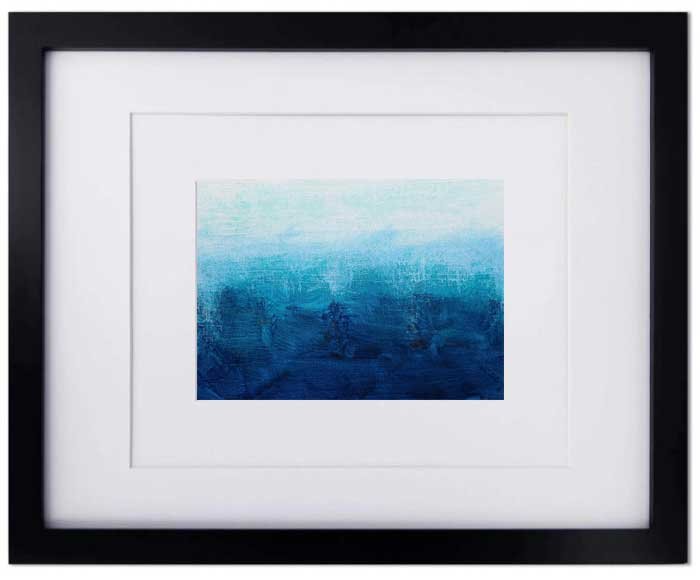Framing Canvas Art: An Easy Step-by-Step Tutorial
(I’ve included several examples of my abstract art in virtual frames, unframed and placed so you can see the difference framing can make!)
*This post includes some affiliate links to frame and art options. I will receive a small commission from any purchases made from these linked items. Thank you!
Welcome to this easy guide for framing canvas art!
Whether you're a professional artist or an art enthusiast, framing plays a crucial role in showcasing and preserving your canvas creations. In this step-by-step tutorial, we will take you through the entire process of framing canvas art, from choosing the right materials to giving your artwork the perfect finishing touch.
With clear and concise instructions, we will help you select the ideal frame that complements your artwork and enhances its visual impact. We'll guide you in selecting the right matting and glass options to protect your canvas from dust and damage while maintaining its authenticity.
NOTE: Choosing a matte for small pieces can help create a larger look by adding dimension.
You will need a larger frame for matted artworks.
For example: DOUBLE MATTE + FRAME = LARGER ARWORK
If your piece is 8” x 10” and you choose a matte with a final size of 11” x 14” or larger. You can even double matte a painting and make it even larger, as shown above.
The artwork above, LITTLE WATERS, is an original painting 5” x 7”. It has been framed in an 11” x 14” frame with a double matte. (Example double-matte frame).
From measuring your canvas and preparing the frame to attaching the artwork securely, we'll cover what you need. Plus, we'll provide expert tips and tricks to ensure a professional and flawless result, every time.
Framing art is relatively easy, so don't let the art of framing intimidate you. With this guide, you'll gain the confidence and knowledge to frame your canvas art with ease.
FRAMING YOUR ART: GETTING STARTED
While framing canvas art is an aesthetic choice; it serves several important purposes.
1. First and foremost, a frame provides protection for your artwork. It acts as a barrier, shielding your canvas from dust, moisture, and other potential hazards.
2. Additionally, a well-chosen frame can enhance the visual impact of your artwork, drawing attention to its unique qualities and adding a touch of elegance.
When you invest time and effort into creating a beautiful canvas art piece, it's essential to safeguard it against the test of time. By framing your artwork, you ensure its long-term preservation and prevent any potential damage that could occur if left unprotected.
CHOOSING THE FRAME
Selecting the right frame for your canvas art is a crucial step in the framing process. The frame you choose should complement your artwork while also reflecting your personal style and preferences. There are several factors to consider when making this decision, such as the color, style, and material of the frame.
To start, consider the color palette and subject matter of your artwork. A frame that harmonizes with the colors in your piece can create a cohesive and visually pleasing result. For vibrant and bold artworks, a neutral frame can help balance the composition. On the other hand, a more ornate frame can add a touch of elegance to traditional or classical artwork.
For modern and abstract pieces, the choice is usually a simple box frame or a floating frame. A floating frame is great for pieces that are deeper (gallery-wrapped).
FLOATER FRAME
Easily insert your canvas into a floater frame.
Sometimes, very modern work is framed in a gilt/antique frame so really juxtapose the styles: modern vs. ornate/traditional.
Example: A modern impressionist-style abstract in a golden gilt frame.
The material of the frame is another important consideration. Wood frames are a popular choice due to their versatility and timeless appeal. They come in various finishes, from natural wood tones to painted options. Metal frames, such as aluminum or stainless steel, offer a sleek and modern look, ideal for contemporary and minimalist artworks.
PREPARING TO FRAME: Measure and prepare canvas
Before you can start framing your canvas art, it's crucial to measure and prepare the canvas properly. This step ensures that your artwork fits snugly within the frame and remains securely in place.
To begin, measure the dimensions of your canvas. Use a tape measure to accurately determine the width and height of your artwork. Remember to account for any additional space you may want to leave between the canvas and the frame.
Once you have the measurements, it's time to prepare the canvas for framing. Lay the canvas face down on a clean and flat surface. Ensure that the surface is free from any debris or dust that could transfer onto the canvas.
TIP: It’s often a good idea to cut a cardboard piece in the size of the final frame and attach it to your wall. It can give you an idea if the frame is a good fit (vs. too small or too large). You can make adjustments to make the final piece larger by matting your artwork and then choosing a larger frame.
FRAMING: Mounting the canvas
Mounting the canvas in the frame is a critical step that requires precision and care. This process ensures that your artwork remains securely in place, preventing any movement or damage.
To mount the canvas, start by positioning it face down on a clean and soft surface (a large clean towel or sheet is a great option). Place the frame face down on top of the canvas, aligning the edges. Ensure that the frame is centered and level with the canvas.
Next, carefully fold the excess canvas around the back of the frame, securing it in place with staples or framing points. Start at the top and work your way down, ensuring that the canvas is taut and wrinkle-free. Make sure to space the staples or framing points evenly along each side.
Canvas board artwork is super easy to frame! You can just slip this into any frame, poster/photo or floater frame and display, like this modern simple white frame.
ART SHOWN: Black Matter
PLACING-SECURING CANVAS IN FRAME
Once the canvas is mounted in the frame, it's time to secure it to ensure it remains in place. This step is crucial to prevent any shifting or movement of the artwork within the frame.
To secure the canvas, use framing screws or offset clips. These devices will hold the canvas firmly against the back of the frame, keeping it taut and secure. Place the screws or clips along each side of the frame, ensuring equal spacing to maintain an even tension.
CAUTION:
Take care not to overtighten the screws or clips, as this can cause the canvas to stretch or warp. Aim for a firm but gentle hold to keep the canvas in place while allowing for slight adjustments if needed.
HANGING HARDWARE – How to add it to your framed art
Adding backing and hanging hardware is the final step in framing your canvas art. This step ensures that your artwork is well-protected and ready to be displayed.
Start by attaching a dust cover or backing board to the back of the frame. This will protect the back of the canvas from dust, moisture, and other potential damage. Use acid-free materials to prevent any chemical reactions that could harm your artwork over time.
Next, attach the hanging hardware to the back of the frame. Depending on the size and weight of your artwork, you may need to use D-rings, wire, or sawtooth hangers. Ensure that the hanging hardware is securely attached and can support the weight of the frame and canvas.
PICTURE FRAME HANGING KIT - always a good idea to have these option when hanging any art or photos!
BENEFIT OF USING SAWTOOTH HANGERS TO HANG ART: D-rings and sawtooth hangers are an easy way to add hanging hardware without the need to add a wire. Wired art is nice, but it can shift easily, while using a sawtooth can help secure the art and prevent shifting and crooked artwork.
MAINTAINING YOUR FRAMED ART
Once you have successfully framed your canvas art, it's important to follow some maintenance tips to ensure it look “gallery fresh” for years.
AVOID SUN AND LIGHT: Firstly, avoid hanging your framed artwork in direct sunlight or areas with high humidity. Exposure to sunlight can cause fading and damage to the canvas and frame over time.
AVOID HUMIDITY: High humidity can lead to mold or moisture-related issues that can affect the integrity of your artwork.
KEEP IT CLEAN: Regularly dust your framed canvas art using a soft, lint-free cloth or a gentle brush. This will help remove any accumulated dust or debris without causing any damage.
AVOID CHEMICALS/CLEANSERS: Avoid using harsh chemicals or abrasive materials that could scratch or discolor the frame or canvas.
OIL PAINTING CLEANING KIT - If you have an oil painting that needs reviving, use a professional art cleaning kit (like this one). NOTE: Be sure to test it in an inconspicuous spot before working on the entire surface!
INSPECT YOUR ART: Once in a while you should take a few minutes to inspect your framed artwork for any signs of damage or wear. Check for loose screws, broken glass, or any other issues that may require repair or maintenance. Promptly address any problems to ensure the long-term preservation of your artwork.
BUYING QUALITY FRAMES FOR YOUR ART
Finding quality frames for your canvas art is essential to achieve a professional and visually pleasing result. There are several options available, both online and in physical stores.
PROFESSIONAL FRAMER: One popular option is to purchase frames from art supply stores or specialized framing shops. These stores offer a wide range of frame styles, materials, and sizes, ensuring you can find the perfect match for your artwork. Additionally, the staff at these stores can provide expert advice and guidance to help you make an informed decision.
DIY FRAMING: Another option is to explore online retailers that specialize in frames for canvas art. Many online stores offer a vast selection of frames, often at competitive prices. Ensure that you choose a reputable retailer that provides detailed product descriptions and images to make an informed purchase.
By carefully selecting the right frame, measuring and preparing the canvas, and following the proper techniques for mounting and securing the artwork, you can create stunning, gallery-worthy masterpieces.
Remember to choose a frame that complements your artwork and reflects your personal style. Take the time to measure and prepare the canvas accurately, ensuring a snug fit within the frame. Secure the canvas firmly but gently to prevent movement or damage. Add backing and hanging hardware to protect your artwork and make it ready for display.
By following these step-by-step instructions and using the maintenance tips, you can confidently frame your canvas art like a professional.
Here are a few examples of art that has been virtually framed. Sometimes when you can virtually frame a piece you can see how it looks before purchasing the frame.
GOLDRUSH - neutral canvas abstract in a wood frame
PINK SOUL - a bright abstract of color; each framed in a light wood floater frame
SOFTEN MY EDGES - canvas abstract framed
LICORICE HEART - small canvas art painting in a frame with matte
If you need assistance in virtually framing, virtually hanging and/or virtually placing a piece of my art in your space, contact me! I can photos of my art framed, unframed and virtually hang it for you to see prior to purchase!










